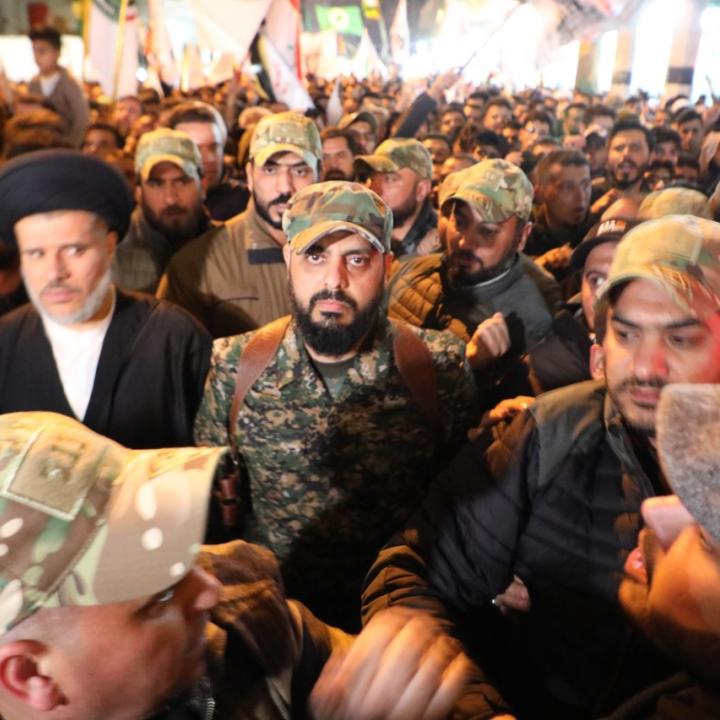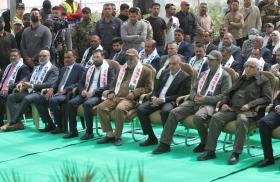
Profile: Asaib Ahl al-Haq
Apr 27, 2021
Also available in
Updated October 21, 2023

About the Authors
Brief Analysis
Part of a series: Militia Spotlight: Profiles
or see Part 1: How to Use Militia Spotlight: Profiles
Asaib Ahl al-Haq is a major Iraqi armed group that identifies as part of Iran's axis of resistance but stubbornly maintains a degree of independence, forming numerous cells to conduct kinetic, media, and social operations, some bankrolled by the Iraqi state.
Name: Asaib Ahl al-Haq (AAH) (League of the Righteous).
Type of movement: Tier 1 fasail (armed group). Kinetic military operations (largely domestic). Social and political wings. Parent organization to multiple facade groups.
History and objectives:
- A splinter of Muqtada al-Sadr’s Jaish al-Mahdi militia that broke away in 2005-2006 with support from Iran's Islamic Revolutionary Guard Corps-Qods Force (IRGC-QF) and Lebanese Hezbollah.
- Formed to undertake anti-U.S. operations in Iraq under the leadership of senior Sadrist religious student Qais al-Khazali, his brother Laith al-Khazali, and Sadrist commander Akram Kaabi.
- Among numerous other military operations, AAH undertook the January 20, 2007, raid on the U.S. base at the Karbala police center that resulted in the kidnapping and murder of five American soldiers. Qais and Laith al-Khazali were detained by the U.S.-led coalition from 2007 to 2010, until their release was brokered for the return of a Western hostage and the bodies of executed Britons.
- After U.S. withdrawal in 2011, AAH tightened its ties to the IRGC-QF’s axis of resistance and sent a contingent to fight in the Syrian civil war under the IRGC-QF's operational control.
- In 2014, AAH entered parliament via its al-Sadiqoun bloc, winning one seat. It increased this tally to fifteen seats in the 2018 election.
- Under the rubric of the Popular Mobilization Forces (PMF), AAH developed a larger state-funded armed force with three brigades. The group consolidated an area of control in the northern arc of Baghdad and adjacent areas such as Balad.
- On December 6, 2019, the U.S. Treasury Department designated Qais and Laith al-Khazali under Executive Order 13818 for their involvement in serious human rights abuses in Iraq, such as approving the use of lethal force against protestors for the purpose of public intimidation.
- On January 3, 2020, the U.S. State Department announced its intent to designate AAH as a Foreign Terrorist Organization (FTO) under Section 219 of the Immigration and Nationality Act. The designation became active on January 10. Qais and Laith al-Khazali were listed as Specially Designated Global Terrorists (SDGTs) under Executive Order 13224, effective January 3, 2020. According to the State Department, AAH and the Khazali brothers were designated for being “violent proxies of the Islamic Republic of Iran...extensively funded and trained by [the IRGC-QF], an entity that was part of the IRGC designation as an FTO in April 2019.”
- On November 19, 2020, Qais al-Khazali appeared on al-Iraqiya TV to announce the end of a truce with U.S. forces (which had previously been announced by Kataib Hezbollah in October 2020).
- After the October 2021 elections, in which AAH's al-Sadiqoun party dropped from 15 seats to 4-5, Qais al-Khazali rejected the election results and publicly threatened the stability of Iraq. Khazali authorized violent protests against the government that resulted in at least one death, and coordinated a drone attack on the house of Prime Minister Mustafa al-Kadhimi on Nov. 7, 2021.
Chain of command:
- “Parochial” Iraqi militia network. Chatham House describes “parochial” networks as those with weak central control but a strong social base, and defines AAH as one such popular militia with a primary focus on power attainment within Iraq. (In contrast, Kataib Hezbollah is defined as a “vanguard” network with strong central control, a weak connection to society, and primary focus on the transnational axis of resistance and IRGC-QF agenda).
- Partly financed by the Iraqi state. AAH operates the state-funded 41st, 42nd, and 43rd Brigades of the PMF. Chain of command nominally runs through the Popular Mobilization Commission of the Prime Minister's Office and up to the prime minister. In practice, AAH PMF brigades frequently disobey the Iraqi government chain of command while legally remaining organs of the Iraqi state.
- Iran. There is clear and convincing evidence that AAH is partly financed by the IRGC-QF and sometimes responds to its commands. Credible evidence shows that AAH carries out specific actions under the instructions or control of the IRGC-QF. The preponderance of the evidence shows that the IRGC-QF and Lebanese Hezbollah have provided AAH with financial assistance, military assistance, and intelligence sharing, as well as help in selecting, supporting, and supervising its leadership. On occasion, since 2020, AAH also disobeys Iranian instructions.
Affiliate relationships:
- Rivalry with Kataib Hezbollah, Badr, and other resistance factions, especially concerning profile and recruitment, giving way to coordination when such factions are all threatened.
- Sibling rivalry with Harakat Hezbollah al-Nujaba (HaN), which is led by former AAH member Akram Kaabi.
- Peripheral or unofficial member of the Iraqi Resistance Coordination Committee (al-Haya al-Tansiqiya lil-Muqawama al-Iraqiya, or Tansiqiya for short), though not under the command of other Iraqi fasail.
- Long-term organizational ties to the IRGC-QF and Lebanese Hezbollah, including offices in Iran and Lebanon.
- Member of the Islamic Resistance of Iraq.
Subordinate elements:
- The 41st, 42nd, and 43rd Brigades of the PMF, an Iraqi state organ. These formations are under the administrative and operational control of AAH leaders.
- Multiple covert action roadside bombing, rocket, and assassination cells that may have overlapping membership with AAH's PMF brigades.
- Facade groups:
- The preponderance of the evidence suggests that Ashab al-Kahf is controlled and operated by AAH.
- Evidence supports organizational links between AAH and al-Faqar, the Zulfiqar Brigades, and Liwa al-Shahid Karim Daraem (Brigade of the Martyr Karim Daraem).
- Media networks:
- The preponderance of the evidence suggests that at least part of Sabereen News is controlled by AAH.
- Evidence supports organizational links between AAH and Alfaqaar (as spelled by the group).
- Probable connection to al-Ahad TV.
- Political organization al-Sadiqoun, with 4-5 seats in Iraq's parliament (down from 15 in 2018-2021).





